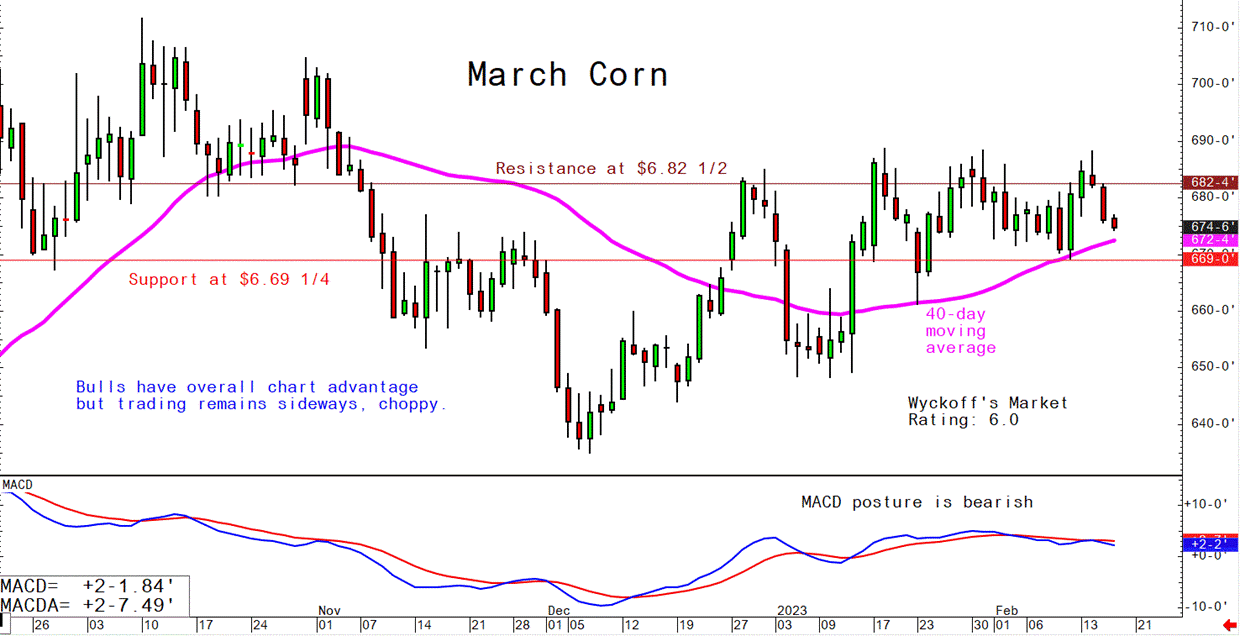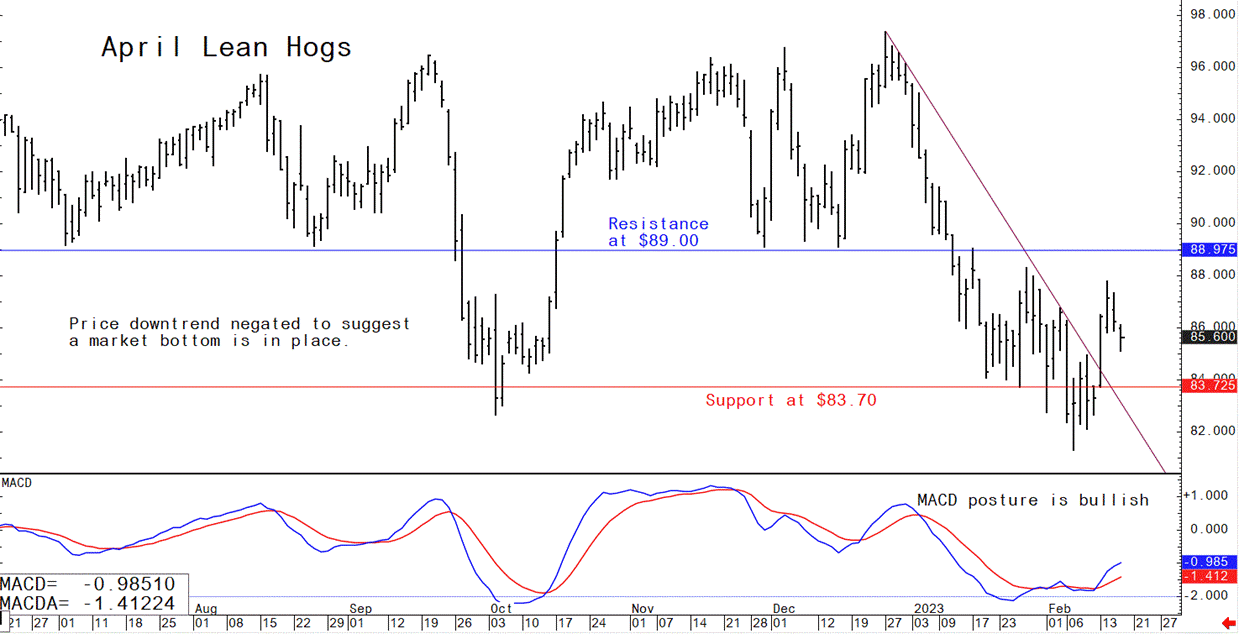



Pig outlook: Lean hog futures showing signs of market bottom
Analyst Jim Wyckoff shares an update on the US futures market, USDA reports and global pig newsUS hog supplies are tightening and wholesale pork and cash hog prices have trended higher lately, even though the rate of gain hasn’t been great. The latest CME cash hog index quote is $75.62. Look for hog and pork prices to advance in the coming days and weeks ahead. Having last week’s kill fall below the comparable year-ago figure for the first time this year was a big step in that direction. It will help the bulls if forthcoming slaughter rates match the implicit USDA forecast of supplies consistently falling 2% below year-ago levels. Pork cutout has also risen about $5.40 from the Jan. 17 low of $77.44. While consumer and grocer demand for most cuts may not prove strong with Lent looming, industry demand for hams to be featured for Easter dinner should provide solid support. Demand for the other cuts should surge as Easter (on April 9), and the unofficial start of grilling season, nears.
Weekly USDA pork export sales
USDA Thursday reported US pork net sales of 45,000 MT for 2023 were up 56 percent from the previous week and 30 percent from the prior 4-week average. Increases primarily for Mexico (18,800 MT, including decreases of 200 MT), Japan (11,500 MT, including decreases of 100 MT), South Korea (4,400 MT, including decreases of 700 MT), China (4,100 MT, including decreases of 100 MT), and Colombia (1,200 MT), were offset by reductions for Nicaragua (100 MT). Exports of 30,500 MT were unchanged from the previous week, but down 4 percent from the prior 4-week average. The destinations were primarily to Mexico (13,400 MT), China (4,100 MT), Japan (3,500 MT), South Korea (2,600 MT), and Canada (2,300 MT).
China to strengthen regulation of hog production
Part of China’s No. 1 document, the blueprint for agricultural policy, includes strengthening regulation of its hog production capacity, mainly for breeding sows. Details of the new regulations are lacking, though following the African swine fever outbreak, China has pushed more production to major hog farms and tried to eliminate smaller backyard herds.
USDA Livestock, Dairy, and Poultry Outlook: February 2023
Pork/Hogs: January hog slaughter and pork production was higher than expected, although anticipated lower dressed weights are expected to mitigate the effect of the higher numbers on quarterly production. First-quarter pork production is reduced 32 million pounds to 7.010 billion pounds, 1.5 percent higher than production a year ago. First-quarter hog prices are reduced $5 per hundredweight (cwt) to $58 per cwt on general weak demand for pork cuts. Pork exports for 2022 wrapped up at 6.3 billion pounds, 9.8 percent lower than shipments in 2021. Exports are forecast at 6.35 billion pounds in 2023, up fractionally from last year.
January US Pork Production Above Expectations
When all was said and done, the estimated January federally inspected (FI) hog slaughter came in at a larger-than-anticipated 11.1 million head, a volume almost 7 percent higher than that of January 2022.7 Timewise, the January 2023 FI estimate largely comprised the December 1 heavyweight category of the December Quarterly Hogs and Pigs report. January’s FI slaughter volume turned out to also be somewhat larger than what the report implied for the heavyweight hog category. Part of that divergence may have been due to the adverse weather in several pork producing regions of the country during December that affected slaughter schedules. Consequently, hog slaughter was reduced prior to Christmas, backing up hogs, but then jacked up in January to reduce the backup. Weekly January dressed weights declined, however, compared to same-period weights last year, ending the month averaging about 219 pounds, unchanged from a year ago. The January 2023 dressed-weight scenario is likely a sign that the processing industry has been working through any earlier backed-up hog situations.
Processors paid lower prices for larger supplies of hogs in January. Prices of live equivalent 51- 52 percent lean hogs averaged $53.82 per cwt, almost 4 percent lower than prices averaged in January 2022. The larger January hog slaughter translated into larger supplies of pork—2.4 billion pounds, up more than 6 percent year over year—for which pork wholesalers paid hog processors lower prices. The January wholesale carcass cutout averaged to $81.03, down 10.52 percent from a year earlier. Disaggregating the cutout to its primal components indicates that bellies accounted for the largest share of the year-over-year decline of the carcass value; the belly primal declined almost 39 percent from $148.14 per cwt in January 2022 to $90.94 per cwt last month. With the break in belly prices since the fourth quarter of 2022, it is not surprising that ending stocks for December 2022 (the last data point for cold stocks currently available) shows belly stocks largely recovered to pre-pandemic levels. The deep discount in January 2023 belly prices compared to past years may create incentives to further increase stock volumes in early 2023
First-quarter pork production is reduced fractionally to 7.010 billion pounds on expectations of lower averaged dressed weights, a volume still about 2 percent higher than production in the same period of 2022. Succeeding quarterly production forecasts are unchanged. Quarterly production forecasts for 2023 total to about 27.4 billion pounds, 1.6 percent higher than production in 2022. Prices of first-quarter live equivalent 51-52 lean hogs are expected to average $58 per cwt, almost 12 percent lower than a year earlier. Second-quarter prices are reduced to $71 per cwt, about 6 percent lower than same-period prices last year. For 2023, quarterly hog price forecasts average to about $67 per cwt, almost 7 percent below average prices last year.
Pork Exports Finish 2022 Down 10 Percent for the Year
Although fourth-quarter pork exports had a solid finish—shipments of almost 1.7 billion pounds were about 1.6 percent higher than a year earlier, mostly on the strength of year-over-year larger shipments to Mexico and China—total U.S. exports ended 2022 at 6.3 billion pounds, about 10 percent below volumes in 2021. Most of the shortfall in 2022 was due to lower shipments to China\Hong Kong, for reasons attributable to recovery in the Chinese pork sector as well as to disruptions in the Chinese economy throughout the year, both of which had the effect of reducing demand for foreign pork. Chinese Government data indicate that China’s 2022 pork imports declined by more than 50 percent, with all major pork exporters absorbing part of the steep reduction.
A warning about China’s hog industry
“U.S. hog farmers look at the pictures of those farms in China, and they just scratch their heads and say, ‘We would never dare do that.’” — Brett Stuart, founder of the research firm Global AgriTrends, is worried about disease risks from China’s high-density pig farms, which in some cases pack the animals into tower blocks, according to a news report from the New York Times.
The next week’s likely high-low price trading ranges:
April lean hog futures--$83.00 to $90.00 and with a sideways-higher bias
March soybean meal futures--$480.00 to $520.00, and with a sideways-higher bias
March corn futures--$6.60 to $6.88 3/4 and a sideways bias
Latest analytical daily charts lean hog, soybean meal and corn futures












